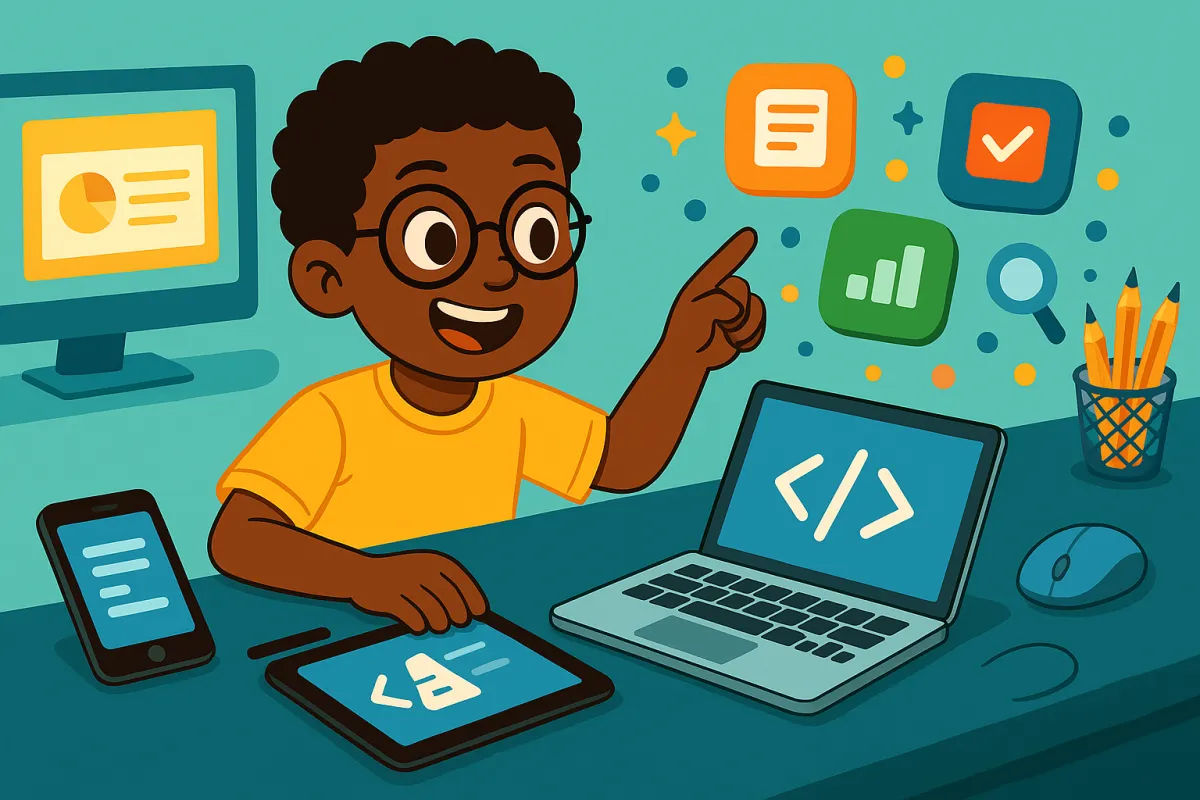
Digital Tools Every K–8 Learner Should Know by Age 12
Because “Tech-Savvy” Shouldn’t Start in High School
There was a moment last year when a bright 6th grader looked up at me and asked, “What’s a Google Doc?” I blinked. Not because it was a strange question, but because I’d just assumed all kids knew. That moment reminded me: being born into a digital world doesn’t mean you know how to use it.
As a science teacher who's worked with hundreds of students, I’ve seen firsthand how digital tools can empower learners—or hold them back if they’re not taught intentionally. Knowing how to open a laptop isn’t the same as knowing how to research safely, collaborate on a project, or format a slide deck that communicates ideas clearly.
So, let’s break down what every K–8 student should be familiar with before they head into middle school. These tools build not just tech fluency, but also the confidence to explore, create, and problem-solve—essential STREAM skills we value at Skhillz Academy.
🧰 1. Word Processing Tools (Google Docs or Microsoft Word)
By age 12, your child should know how to:
Create a new document
Type, edit, and format text
Use bold, italics, bullet points, and headers
Insert images and hyperlinks
Share a document for collaboration
Why it matters: Writing is still the foundation of academic success, even in a digital world. Whether it’s a lab report, a story, or a history paper, word processing is the new notebook.
Anecdote: One of my 5th graders once submitted a science report entirely in Comic Sans—because they thought “fun font = better grade.” It was a perfect moment to teach about tone, readability, and audience awareness.
📊 2. Presentation Tools (Google Slides, PowerPoint, or Canva)
Skills to know:
Create a basic slide deck
Insert images, text boxes, and video clips
Use transitions without going overboard (we’ve all seen that presentation)
Speak confidently with visual support
Why it matters: Presenting ideas is a 21st-century skill, and visuals help students become better communicators. These tools blend creativity with critical thinking.
Pro Tip: Canva is a great tool for kids who want more design freedom—it feels less “school-ish” and more like a creative studio.
🔍 3. Search & Research Skills (Google, Safe Search Engines)
By age 12, learners should be able to:
Use keywords to search efficiently
Distinguish between credible and non-credible sources
Understand how to avoid plagiarism and cite sources
Spot ads, sponsored content, and misinformation
Why it matters: Information is everywhere—but that doesn’t mean it's all useful or true. Teaching kids how to ask better questions and find solid answers builds research resilience.
Anecdote: One student once told me Pluto was “definitely a planet again” because “Google said so.” That led us to compare sources and learn what makes something reliable.
🧮 4. Basic Spreadsheet Tools (Google Sheets or Excel)
What they should know:
How to enter and organize data
Use basic formulas like SUM or AVERAGE
Create simple charts or graphs
Understand rows, columns, and cells
Why it matters: Spreadsheets teach logic, math, and organization. Whether tracking reading minutes or science data, this tool builds digital numeracy.
Parent Tip: Have your child create a weekly schedule in a spreadsheet—it teaches time management and formatting.
👨👩👧👦 5. Digital Citizenship Tools (Google Workspace, Gmail, Class Apps)
Essential habits:
Managing passwords responsibly
Sending respectful emails
Understanding digital footprints
Navigating class platforms (like Google Classroom or Seesaw)
Why it matters: A tool is only as powerful as the person using it. Teaching digital etiquette, safety, and responsibility early on helps kids become ethical users of technology.
Anecdote: I once had a student accidentally hit “Reply All” with a meme... on a schoolwide email thread. That turned into a perfect (and hilarious) teachable moment about digital boundaries.
💻 6. Typing Practice Tools (TypingClub, Nitro Type, BBC Dance Mat)
By age 12, students should:
Use proper hand positioning (no chicken-pecking!)
Type at a comfortable speed (20–30 WPM for middle school is great)
Improve accuracy over speed
Why it matters: Typing is still one of the most overlooked foundational skills. Strong typing means faster writing, better testing outcomes, and less frustration.
Pro Tip: Let them race you. Typing games are an easy win-win.
Final Thought from a Teacher Who’s Seen It All
Kids don’t need to be coding experts by 12, but they should feel confident and capable using digital tools to express themselves, collaborate, and solve problems. That’s why at Skhillz Academy, we intentionally build digital literacy into every STREAM subject—not as an add-on, but as a foundational skill.
Because the goal isn’t just to raise kids who can use tech—it’s to raise innovators who can think with it.
Want to see how we weave these tools into real-world projects and STREAM challenges?
✨→ Explore our programs at Skhillz Academy
Let’s raise creators, not just consumers.
Skhillz Academy: STREAM Learning That Grows With Your Child
At Skhillz Academy, we offer a vibrant, flexible, and hands-on K–12 online learning experience built to nurture creativity, critical thinking, and future-ready skills—wherever your family is in the world.
We proudly support students in the U.S. and internationally through the following programs:
🎓 Online Kindergarten Discovery Program
📚 Online Elementary Academy (Grades 1–5)
🧠 Online Middle School Experience (Grades 6–8)
🚀 High School Launchpad (Grades 9–12)
✝️ Christian-Based & Secular Homeschool Curriculum Options
💡 STREAM-Focused Learning in Science, Tech, Reading, Engineering, ELA, Art & Math
🎓 Advanced & Enrichment Tracks for College and Career Readiness
Every program is flexible, accredited, and led by passionate educators who support each learner’s journey at their own pace—while delivering engaging, real-world curriculum and project-based learning.
📞 Have Questions About Online Learning?
We’d love to help you find the right fit for your child’s needs. Our team is ready to answer your questions about enrollment, curriculum, or how Skhillz can support your family’s goals.
Call us: (888) 425-5094
Email: [email protected]
Submit an inquiry: https://skhillzacademy.org/contact-us
Let’s build brilliance—one Skhillz Scholar at a time.
